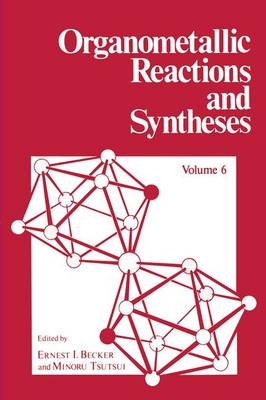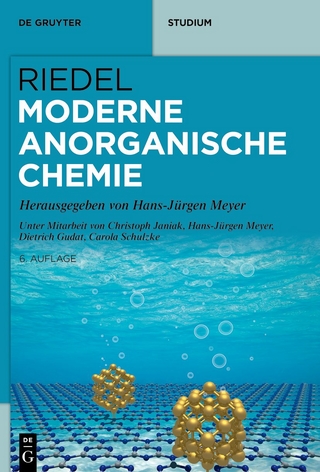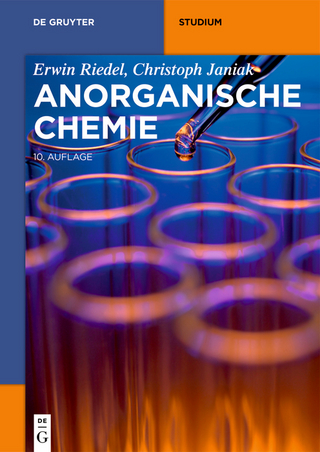
Organometallic Reactions and Syntheses
Plenum Publishing Corporation (Verlag)
978-0-306-39906-0 (ISBN)
- Titel ist leider vergriffen;
keine Neuauflage - Artikel merken
1 Vinyl Polymerization of Organic Monomers Containing Transition Metals.- I. Introduction and Scope.- II. Polymerization and Copolymerization of Vinyl Monomers Containing Ferrocene.- A. Homopolymerization.- B. Copolymerization of Vinylferrocene.- C. Isopropenylferrocene Polymerization.- D. Acrylic Ferrocene Monomers.- E. Miscellaneous Ferrocene Monomers.- III. Polymerization and Copolymerization of Ethynylferrocene.- IV. Polymerization and Copolymerization of Vinyl Organometallic Carbonyl Derivatives.- A. Vinylcyclopentadienyltricarbonylmanganese.- B. Monomers with ?6-Phenyltricarbonylchromium Groups.- C. ?4-(2,4-Hexadiene-1-yl acrylate)tricarbonyliron.- D. Titanium Acrylates.- V. Polymerization of 1,1?-Disubstituted Ferrocenes.- VI. Other Monomers.- VII. Example Monomer and Polymer Syntheses.- A. Homopolymerization of Vinylferrocene.- B. Copolymerization of Vinylferrocene.- C. Preparation of Isopropenylferrocene.- D. Synthesis and Homopolymerization of Ferrocenylmethyl Acrylate.- E. Synthesis and Homopolymerization of 1-Ferrocenyl-1,3-butadiene.- F. Synthesis and Polymerization of Ethynylferrocene.- G. Synthesis and Polymerization of Vinylcyclopentadienyltricarbonylmanganese.- H. Synthesis and Copolymerization of Styrenetricarbonylchromium.- I. Synthesis and Polymerization of Acrylic Monomers Containing ?6-Aryltricarbonylchromium.- J. Synthesis and Polymerization of ?4-(2,4-Hexadien-1-ylacrylate)tricarbonyliron.- K. Synthesis and Polymerization of 1,1?-Divinylferrocene.- L. Synthesis and Polymerization of trans-Chloro(4-vinylphenyl)-bis(tributylphosphine)palladium(II).- References.- 2 Reactions of Metallocarboranes.- I. Introduction and Scope.- II. Structures and Bonding.- A. General Observations.- B. Qualitative Bonding Descriptions.- C. Metallocarboranes as Metal Complexes.- D. Nomenclature and Numbering.- III. Synthetic Routes to Metallocarboranes.- A. General Observations.- B. Synthesis from Open-Cage Carboranes.- 1. Small Nido-Carboranes.- 2. C2B9H13 and C2B7H13.- 3. (CH3)4C4B8H8.- C. Synthesis from Polyhedral Carboranes.- 1. Methods and Starting Materials.- 2. Base Degradation.- 3. Reductive Cage Opening (Polyhedral Expansion).- 4. Polyhedral Contraction.- 5. Direct Metal Insertion.- 6. Metal Replacement in Metallocarboranes.- D. Synthesis from Metalloboranes.- E. Synthesis from Boranes.- F. Other Potential Routes to Metallocarboranes.- IV. Dicarbon, Tricarbon, and Tetracarbon Transition-Metal Metallocarboranes.- A. Titanium, Zirconium, and Vanadium Compounds.- B. Chromium, Molybdenum, and Tungsten Compounds.- 1. Twelve-Atom Cages.- 2. Thirteen-Atom Cages.- C. Manganese and Rhenium Compounds.- 1. Seven-Atom Cages.- 2. Nine-Atom Cages.- 3. Twelve-Atom Cages.- D. Iron Compounds.- 1. Six-, Seven-, and Eight-Atom Cages.- 2. Nine-, Ten-, and Eleven-Atom Cages.- 3. Twelve-Atom Cages.- 4. Thirteen-Atom Cages.- 5. Fourteen-Atom Cages.- E. Ruthenium Compounds.- F. Cobalt Compounds.- 1. General Comments.- 2. Six- and Seven-Atom Cages.- 3. Eight-, Nine-, and Ten-Atom Cages.- 4. Eleven-Atom Cages.- 5. Twelve-Atom Cages.- 6. Thirteen- and Fourteen-Atom Cages.- G. Rhodium Compounds. Catalytic Activity of 2,1,2- and 2,1,7-[(C6H5)3P]2Rh(H)C2B9H11.- H. Nickel Compounds.- 1. Seven- and Nine-Atom Cages.- 2. Ten-Atom Cages.- 3. Twelve-Atom Cages.- 4. Thirteen-Atom Cages.- I. Palladium and Platinum Compounds.- J. Copper Compounds.- K. Silver and Gold Compounds.- V. Monocarbon Transition-Metal Metallocarboranes.- A. Introduction.- B. Synthesis via Monocarbon Carborane Anions.- C. Synthesis via Carbonyl Insertion into B10H13?.- VI. Transition-Metal Phospha- and Arsametallocarboranes.- A. Synthetic Routes.- B. Manganese Compounds.- C. Iron Compounds.- D. Cobalt Compounds.- E. Nickel Compounds.- VII. Metallocarboranes of the Main-Group Metals.- A. Introduction.- B. Beryllium Compounds.- C. Aluminum, Gallium, Indium, and Thallium Compounds.- 1. General Comments.- 2. Seven-Atom Cages.- 3. Twelve-Atom Cages.- D. Germanium, Tin, and Lead Compounds.- 1. General Comments.- 2. Dicarbon-Cage Systems.- 3. Monocarbon-Cage Systems.- References.- 3 Homogeneous Catalysis by Arene Group-VIB Tricarbonyls.- I. Introduction.- II. Chemistry of Arene Group-VIB Tricarbonyls.- A. Displacement of the Arene Ring by Donor Molecules.- B. Ring Exchange with Other Aromatic Molecules.- C. Substitution on the Coordinated Arene.- D. Reactions on Functional Groups on the Coordinated Arene.- E. Substitution of CO.- F. Total Substitution of Arene and CO.- G. Addition and Oxidative Addition.- H. Summary.- I. Experimental Procedures.- III. Friedel-Crafts and Related Reactions.- A. Reactions Promoted by the Catalysts.- B. Experimental Features.- C. Nature of the Catalyst.- D. Type of Reaction.- E. Mechanism.- F. Related Reactions.- G. Experimental Procedures.- IV. Hydrogenation of Olefins.- A. Reactions Promoted by ArM(CO)3 and Related Catalysts.- B. Features of Hydrogenation.- C. Mechanism.- D. Experimental Procedures.- V. Isomerization of Olefins.- A. Reactions Promoted by ArM(CO)3 and Related Catalysts.- B. Discussion.- C. Mechanism.- D. Experimental Procedures.- VI. Olefin Metathesis.- A. Homogeneous Systems.- B. Heterogeneous Systems.- VII. Reactions of Acetylenes.- A. Trimerization.- B. Polymerization.- C. Experimental Procedures.- VIII. Polymer-Bound Systems.- A. Hydrogenation of Methyl Sorbate.- B. Friedel—Crafts Reactions.- C. Experimental Procedures.- References.
| Erscheint lt. Verlag | 1.10.1977 |
|---|---|
| Zusatzinfo | Bibliography |
| Verlagsort | New York |
| Sprache | englisch |
| Themenwelt | Naturwissenschaften ► Chemie ► Anorganische Chemie |
| Naturwissenschaften ► Chemie ► Organische Chemie | |
| ISBN-10 | 0-306-39906-7 / 0306399067 |
| ISBN-13 | 978-0-306-39906-0 / 9780306399060 |
| Zustand | Neuware |
| Haben Sie eine Frage zum Produkt? |
aus dem Bereich


